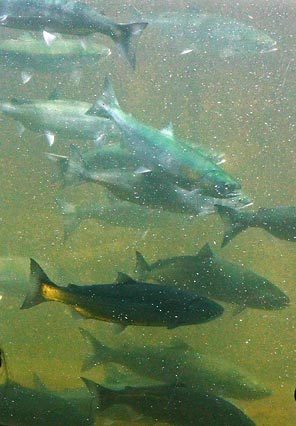forum
library
tutorial
contact

A Record Summer for Returning Sockeye
by Scott LearnThe Seattle Times, July 26, 2008
|
the film forum library tutorial contact |

|
A Record Summer for Returning Sockeyeby Scott LearnThe Seattle Times, July 26, 2008 |
 PORTLAND - Sockeye salmon, an oceangoing species that starts and ends its life hundreds of river miles inland, are swimming up the Columbia River this summer in numbers unseen in five decades.
PORTLAND - Sockeye salmon, an oceangoing species that starts and ends its life hundreds of river miles inland, are swimming up the Columbia River this summer in numbers unseen in five decades.
No one knows exactly why. Some say it's because federal courts ordered the release of extra water over dams in 2006 and 2007 to make passage easier when the fish were young and migrating to sea. Others cite improved ocean conditions.
The undisputed fact: Sockeye salmon runs have hit historic post-dam-construction highs this summer in the Columbia and Snake rivers, an unexpected positive sign for a species close to being written off in parts of the Pacific Northwest's largest river system.
The fish counts, which have surprised the experts, include nearly 215,000 red salmon counted at Bonneville Dam through Tuesday, the biggest number of adults returning from the ocean since 1955.
Most of those fish followed the Columbia River up to Washington's Wenatchee and Osoyoos lakes, while a far smaller number - representing the system's most endangered run - swam on to Lower Granite Dam on the Snake River. With the journey past the dams nearly over, the count of returning adult sockeye there topped 800 through Tuesday.
That's a tiny number in relative terms, and the Snake River fish still have to make it to their home lakes in central Idaho. But it's the highest sockeye return recorded at Lower Granite since it was built in 1975, and nearly 25 times the average return of the past 10 years. Ten years ago, two sockeye came back.
8 dams, 450 miles
The returning Snake River sockeye, remnants of the first population to be listed as endangered on the Columbia system 17 years ago, were all likely produced by a "duplicate broodstock" hatchery program in central Idaho that is trying to keep the genetic lineage of wild Snake River sockeye alive.
The fish topping Lower Granite traveled from the ocean over eight dams and 450 river miles to get by the fourth of four hydroelectric dams on the lower Snake.
That marathon run and the higher numbers demonstrate that the fish, despite their small numbers, "haven't lost the long-standing traits that this population has deployed to survive for the last 10,000 years," said Paul Kline, assistant fisheries-bureau chief for the Idaho Department of Fish and Game.
The good sockeye news follows on relatively good returns of spring chinook to the Columbia and good early indications on steelhead. But this being salmon in the Northwest, the focus has turned from applauding the sockeye numbers to fiercely debating why they're so high.
Ocean conditions have improved, including more nutrient-rich upwelling. Sockeye hatcheries on both the Snake and the Columbia have significantly increased their smolt production, with releases nearly quadrupling in the past three years on the Snake.
And - most politically sensitive - a federal judge ordered federal agencies to boost springtime spills over key hydropower dams when the fish that are returning today were migrating to the ocean as juveniles.
A new report from the Columbia Basin Fish Passage Center credits the sockeye spike to the court-ordered spills along with better river flow and the higher hatchery releases.
Michele DeHart, the Portland-based center's manager, said her analysis indicates survival of juvenile sockeye headed to the ocean in 2006 and 2007 improved significantly after U.S. District Court Judge James Redden ordered more spill for fish in late 2005. The better flows speed the fish's trip to the ocean, she said.
"The fish are telling us something as to what set of conditions works for them," DeHart said. "Sockeye like a lot of flow and they like spill."
Many salmon advocates would ultimately like to see the four lower Snake River dams breached to give sockeye, steelhead and other salmon better access to relatively pristine habitat above the dams.
learn more on topics covered in the film
see the video
read the script
learn the songs
discussion forum
